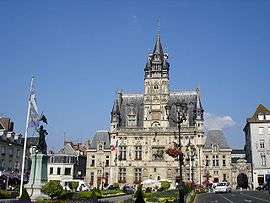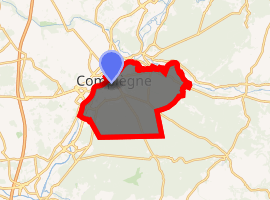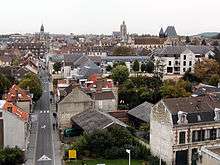Compiègne
Compiègne (French pronunciation: [kɔ̃pjɛɲ]; Picard: Compiène) is a commune in the Oise department in northern France.[2] It is located on the Oise River.[2] Its inhabitants are called Compiégnois.
Compiègne | |
|---|---|
Subprefecture and commune | |
 Town hall | |
.svg.png) Coat of arms | |
Location of Compiègne 
| |
 Compiègne  Compiègne | |
| Coordinates: 49°24′54″N 2°49′23″E | |
| Country | France |
| Region | Hauts-de-France |
| Department | Oise |
| Arrondissement | Compiègne |
| Canton | Compiègne-1 and 2 |
| Intercommunality | Région de Compiègne |
| Area 1 | 53.1 km2 (20.5 sq mi) |
| Population (2017-01-01)[1] | 40,199 |
| • Density | 760/km2 (2,000/sq mi) |
| Time zone | UTC+01:00 (CET) |
| • Summer (DST) | UTC+02:00 (CEST) |
| INSEE/Postal code | 60159 /60200 |
| Elevation | 31–134 m (102–440 ft) (avg. 41 m or 135 ft) |
| 1 French Land Register data, which excludes lakes, ponds, glaciers > 1 km2 (0.386 sq mi or 247 acres) and river estuaries. | |
Administration
Compiègne is the seat of two cantons:
- Compiègne-1 (with 19 communes and part of Compiègne)
- Compiègne-2 (with 16 communes and part of Compiègne)
History
- 665 - Saint Wilfrid was consecrated Bishop of York. Wilfrid refused to be consecrated in Northumbria at the hands of Anglo-Saxon bishops. Deusdedit, Archbishop of Canterbury, had died, and as there were no other bishops in Britain whom Wilfrid considered to have been validly consecrated, he travelled to Compiègne, to be consecrated by Agilbert, the Bishop of Paris.
- 833 - Louis the Pious (also known as King Louis I, the Debonair) was deposed in Compiègne.[2]
- February 888 - Odo, Count of Paris and king of the Franks was crowned in Compiègne.
- 23 May 1430 - During the Hundred Years' War, Joan of Arc was captured by the Burgundians while attempting to free Compiègne. They then sold her to the English.
1557 Bataille de Saint Quentin 1557 Les Anglais occupe Compiegne-1558
- 1624 - Compiègne gave its name to the Treaty of Compiègne, a treaty of alliance concluded by Cardinal Richelieu with the Dutch.[2]
- 1630 - Marie de' Medici's attempts to displace Richelieu ultimately led to her exile to Compiègne, from where she escaped to Brussels in 1631.
- 17 July 1794 - The Martyrs of Compiègne are executed in Paris during the Reign of Terror.
- 1900 - The golf events for the 1900 Summer Olympics took place.[3]
- 11 November 1918 - The Armistice with Germany (Compiègne), agreed at Le Francport near Compiègne, ends fighting of World War I
- 22 June 1940 - Another Armistice with France (Second Compiègne) was signed between Nazi Germany and the defeated France in Le Francport, near Compiègne, in the same place as in 1918, in the same railroad carriage, but with the seats swapped.
- 1941 - During the German occupation of France, the Compiègne internment camp was established in Compiègne. A memorial of the camp, and another along the railway tracks, commemorate the tragedy.
- 1972 - Creation of the University of Technology of Compiègne
Population
- 1882: 13,393
- 1990: 41,663 (municipal), 44,703 (total)
- 1999: 41,076 (municipal), 44,703 (total), 69,903 (agglomeration), urban (108,234)
Sights


Museums
- Château de Compiègne - the castle itself, and museums of the Second French Empire and of motoring and tourism within its walls
- Musée Antoine Vivenel
- Museum of historic figurines
- Memorial of internment and deportation
Compiègne Forest
The Glade of the Armistice in the Compiègne Forest was the site of the signing of two armistices; those of 11 November 1918 and 22 June 1940. Hitler specifically chose the location of the second, and had the original signing carriage moved from Paris to Compiègne, as an irony for the defeated French.
The site still houses several memorials to the 1918 armistice, including a copy of the original railway carriage. The original, Marshal Foch's Carriage was taken to Germany as a trophy of victory following the second armistice. Various rumors about what happened to this railway-carriage thereafter, have flourished ever since. Some believe it was destroyed by the SS in Thuringia in April 1945; others say this happened in Berlin, but most likely was it destroyed during an allied air-raid on Berlin. The latter version seems most plausible, since Ferdinand Foch's carriage actually was displayed at a Berlin museum.[4][5][6]
The University of Technology of Compiègne
Compiègne is home to the University of Technology of Compiègne (UTC), one of the top ranking engineering school in France, founded as a Technology University in 1972 to provide an alternative to the traditional "grandes écoles" for students interested in technologies and applied science.[7]
Transport
The Gare de Compiègne railway station offers connections with Paris, Amiens, Cambrai and several regional destinations. The nearest motorway is the A1 Paris-Lille.
Cycling
Since 1968 Compiègne is the traditional start city of the famous Paris–Roubaix bicycle race. It was also the finish city of 3rd stage in the 2007 Tour de France.
Personalities
Compiègne was the birthplace of:
- Roscellinus (~1050 - ~1122), philosopher and theologian, often regarded as the founder of Nominalism
- Pierre d'Ailly (1350–1420), theologian and cardinal of the Roman Catholic Church
- Albert Robida (1848–1926), illustrator, etcher, lithographer, caricaturist, and novelist
- Eugène Albertini (1880–1941), teacher in Latin literature, historian of ancient Rome, and epigrapher of Latin texts
- Marcel Tabuteau (1887–1966), Oboist, regarded as the founder of American oboe playing.
- Suzanne Lenglen (1899–1938), tennis player, international female sport star
- Lucas Debargue (1990–), pianist and composer who worked in both the classical and jazz fields.
International relations
Twin towns – sister cities
Compiègne is twinned with:
|
Compiègne is also partnered with:
|
See also
- Communes of the Oise department
- Dialogues of the Carmelites
- Martyrs of Compiegne
- Monument aux morts (Oise)
- Siege of Compiègne
- Timeline of deportations of French Jews to death camps
References
- "Populations légales 2017". INSEE. Retrieved 6 January 2020.
- Chisholm, Hugh, ed. (1911). . Encyclopædia Britannica. 6 (11th ed.). Cambridge University Press. p. 811.
- 1900 Summer Olympics official report. p. 15. Accessed 14 November 2010. (in French)
- Moved to Berlin - Steven Budiansky, "The Complete story of Codebreaking during WW2",ISBN 0-684-85932-7, page 136
- Moved to Berlin, and there destroyed in an air-raid - Brian Hanley, "Planning for Conflict in the 21st Century", page 116" available here
- Also William L Shirer in his "The Rise and Fall of the Third Reich" (unknown ISBN) states it was destroyed during a bombing raid on Berlin
- https://www.utc.fr/en/utc.html
- "Elbląg - Podstrony / Miasta partnerskie". Elbląski Dziennik Internetowy (in Polish). Archived from the original on 2011-03-15. Retrieved 2013-08-01.
- "Elbląg - Miasta partnerskie". Elbląg.net (in Polish). Retrieved 2013-08-01.
External links
| Wikimedia Commons has media related to Compiègne. |
- City council website (in French)
- Le musée du château/The Château museum
- Memorial to Nazi/French Internment Camp and Deportations During WW2
- Steven Lehrer's Compiègne site
- Universite de Technologie de Compiegne
- Joan of Arc Captured At Compiegne
- customized transport in compiègne
- Concerts in Compiègne